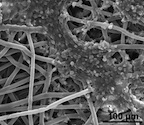3D Scaffolds and Biomechanical Forces Imitate Conditions for Cancer Growth

Scientists from Rice University and University of Texas MD Anderson Cancer Center have developed a new system to test cancer drugs. The researchers have created a 3D scaffold that simulates the bones, and have recreated the forces inside the body which the tumors are subject to. This conditions resulted in an increase in insulin-like growth factor-1 (IGF-1) production, which increases resistance to chemotherapy. The article has been published in PNAS.

An electron microscope image shows Ewing’s sarcoma cells growing on a 3-D scaffold more commonly used for growing tissue for implantation. Growing tumors in the scaffold may provide superior models for testing cancer treatments. From: Rice University.
Drug screenings in vitro often fail to detect the drugs that will work well in vivo, due to lack of physiological signals that happen in the organism. Among them are the biomechanical cues, generally not taken into account. Mikos, Ludwig and colleagues decided to perform an in vitro cancer growth study where mechanical forces were added to the system. Ewing sarcoma cells (which form tumors in the bones of adolescents) were grown on a foam-like 3D scaffold in a flow perfusion bioreactor. The flow mimicked physiological mechanical stress, and the cells subject to it produced more IGF-1. The finding confirms the importance of adding forces to the in vitro system, as the receptor IGF-1R belongs to a pathway involved in tumorigenesis and is an interesting clinical target. Furthermore, the flow increased IGF-1R sensitivity to the inhibitor dalotuzumab. All this confirms the importance of adding biophysical forces when doing in vitro tests. All cells, including cancer cells, react to physical forces inside the organism and adapt to the new conditions. Another advantage over static cultures is a better nutrient supply and thus a higher culture growth.
This method to study cancer cells in vitro is a definite improvement compared to the use of classical monolayer cultures, human tumors or xenografts, allowing a fine-tuned control of conditions. Drug screenings will be far more reliable when finding clinical trial candidates.
Source: Rice University
